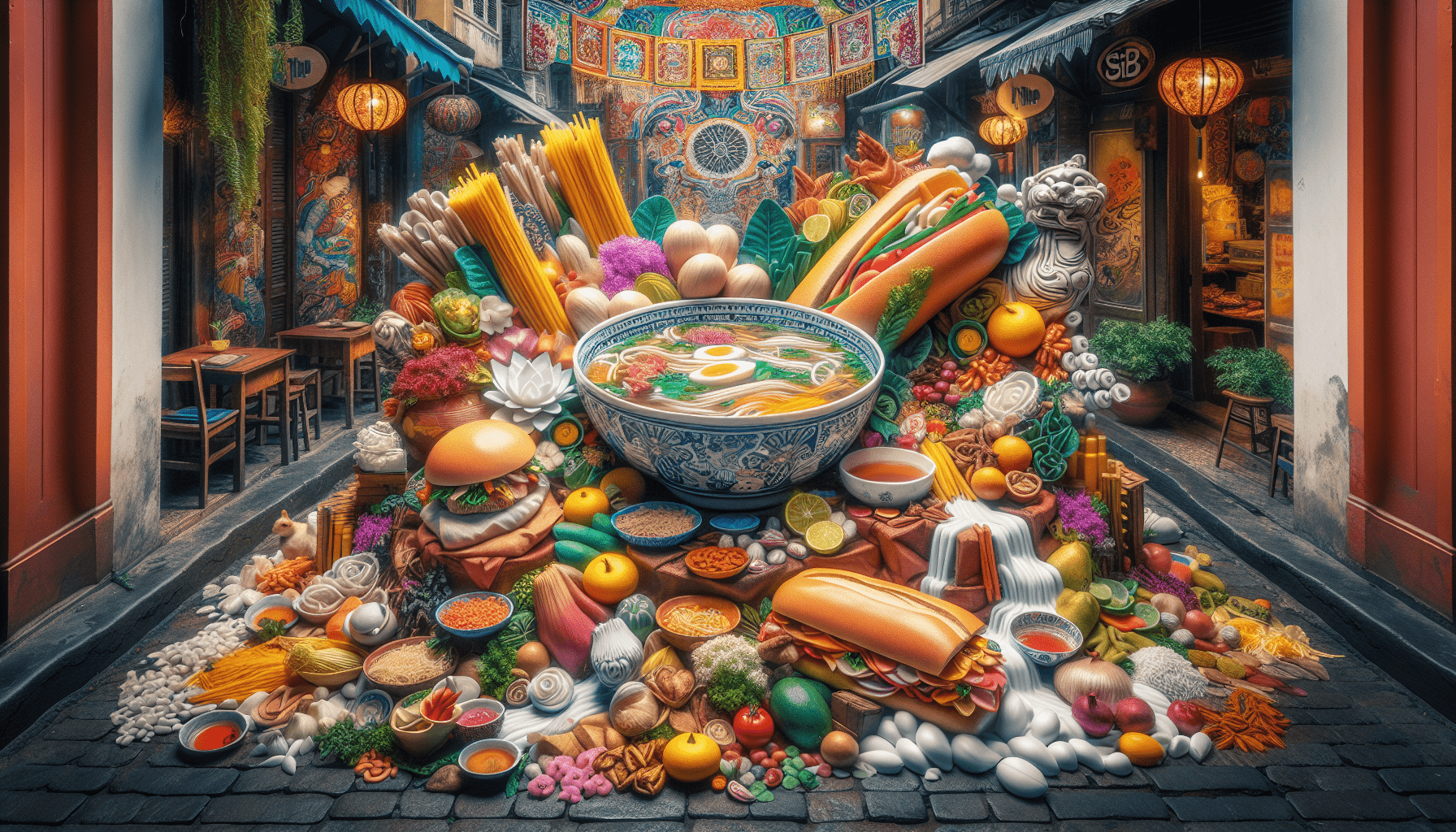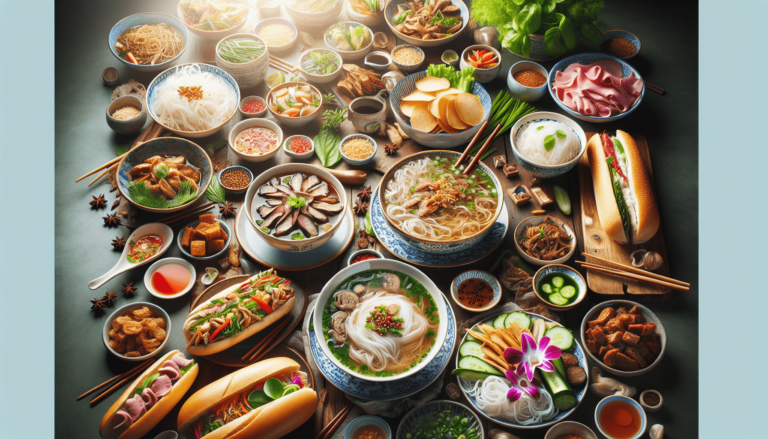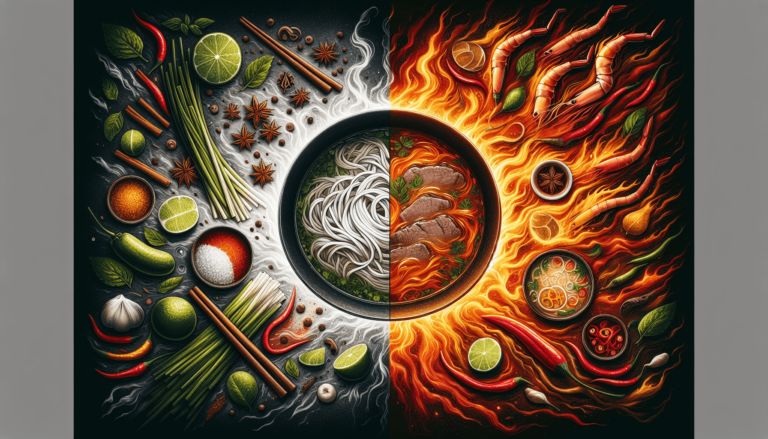If you ever find yourself craving a taste of Vietnam’s culinary wonders, look no further than the main dish that defines the country’s rich gastronomy. Vietnam’s cuisine is a delightful symphony of flavors, blending fragrant herbs, vibrant vegetables, tender meats, and the signature touch of fish sauce. Spanning the length and breadth of the country, this main dish offers a tantalizing glimpse into Vietnam’s culinary heritage. Experience the authentic flavors and vibrant culture of Vietnam by savoring its national dish, a culinary masterpiece that is sure to leave you craving for more. Embark on a journey of taste and tradition, and discover the essence of Vietnam through its main dish. To satisfy your craving right away, head to any of the Eurasian Bistro locations in Pensacola, where you can indulge in a delightful array of Vietnamese delicacies.

Overview of Vietnamese Cuisine
Vietnamese cuisine is known for its fresh and vibrant flavors, which are influenced by both geography and history. The country’s long coastline gives it access to an abundance of seafood, while its agricultural landscapes provide an array of fresh produce and herbs. Additionally, Vietnam’s history of colonization and trade with neighboring countries has contributed to the diversity and uniqueness of its cuisine.
Influence of geography and history on the cuisine
Vietnam’s geographic location has greatly influenced its cuisine. With a long coastline stretching over 3,000 kilometers, seafood plays a significant role in Vietnamese dishes. Rice, another staple of Vietnamese cuisine, is widely cultivated in the fertile deltas of the Red River and Mekong River.
The country’s history also plays a crucial role in shaping its cuisine. Over the centuries, Vietnam has been influenced by various cultures, including China, France, and Cambodia. These influences can be seen in the use of techniques such as stir-frying and braising, as well as the incorporation of ingredients like soy sauce and baguettes.
Dominant flavors and ingredients in Vietnamese dishes
Vietnamese cuisine is characterized by its delicate balance of flavors, with an emphasis on freshness and simplicity. Common ingredients found in Vietnamese dishes include fish sauce, soy sauce, rice vinegar, and a variety of herbs such as cilantro, mint, and Thai basil. These ingredients contribute to the unique taste profile of Vietnamese cuisine, which is a harmonious combination of sweet, sour, salty, and spicy flavors.
Some signature ingredients in Vietnamese cuisine include rice noodles, lemongrass, shrimp paste, and tropical fruits like mango and dragon fruit. These ingredients are used to create a wide range of dishes, from hearty soups to light and refreshing salads.
Role of fresh produce and herbs in Vietnamese cuisine
Fresh produce and herbs are essential components of Vietnamese cuisine, adding fragrance, flavor, and texture to dishes. Vietnamese cuisine places a strong emphasis on the use of herbs such as cilantro, mint, and Thai basil. These herbs are often added as garnishes or incorporated into dishes to enhance their taste and aroma.
In addition to herbs, a wide variety of fresh vegetables and fruits are used in Vietnamese cooking. From crispy bean sprouts and crunchy cucumbers to tangy lime and juicy pineapple, these fresh ingredients add vibrancy and balance to Vietnamese dishes.
Introduction to Pho – Vietnam’s Main Dish
Pho, pronounced “fuh,” is Vietnam’s most famous and beloved dish. It is a traditional Vietnamese soup consisting of broth, rice noodles, and meat, usually beef or chicken. Pho is not only a staple in Vietnamese cuisine but also holds great cultural significance.
Background and origin of Pho
Pho originated in the early 20th century in northern Vietnam and is believed to have been influenced by both Chinese and French cuisines. It was first popularized in Hanoi, the capital city of Vietnam, and later spread throughout the country.
The exact origins of Pho are debated, but it is commonly believed to have originated from a marriage of Vietnamese rice noodle soups and Chinese beef noodle soups. The French presence in Vietnam during the colonial period also influenced the dish, with the introduction of beef as a prominent ingredient.
Significance of Pho in Vietnamese culture and daily life
Pho holds a special place in Vietnamese culture and is deeply intertwined with everyday life. It is commonly enjoyed as a breakfast dish, but it can also be found on the menu for lunch or dinner. Pho is often cooked and enjoyed at home, but it is also readily available in street stalls and restaurants throughout Vietnam.
Sharing a steaming bowl of Pho with family and friends is a cherished social activity in Vietnam. It brings people together, provides nourishment, and evokes a sense of comfort and warmth. Pho is not just a meal; it is a symbol of Vietnamese hospitality and togetherness.
Ingredients that make up Pho
Pho consists of several key components that come together to create its distinctive flavors and textures. From the flavorful broth to the silky rice noodles, each ingredient plays an important role in the overall composition of Pho.
The elements of the Pho broth
The broth is the heart and soul of Pho, simmered slowly to extract maximum flavor from a combination of beef bones, herbs, and spices. The bones, typically beef or chicken, are first blanched to remove impurities before being simmered for several hours.
Herbs and spices such as star anise, cloves, cinnamon, and ginger are added to the broth to infuse it with fragrant aromas and complex flavors. The result is a rich and savory broth that forms the base of the Pho.
Details about the rice noodles used in Pho
The rice noodles used in Pho are thin, flat, and soft, providing a light and delicate texture. Rice flour is mixed with water to form a batter, which is then spread onto large cloth sheets to dry. The dried sheets are then cut into long strips and cooked briefly before being added to the Pho bowl.
The noodles should have a slightly chewy texture, capable of absorbing the flavors of the broth without becoming mushy. They provide a neutral canvas for the other ingredients in Pho and add substance to the soup.
Common meats and veggies found in Pho
Traditional Pho often features thinly sliced beef or chicken as the main protein. Beef can be found in various cuts, such as rare steak, well-done brisket, and beef meatballs. The chicken version typically includes poached or boiled chicken breast.
In addition to the meat, Pho is commonly garnished with an assortment of vegetables and herbs. Bean sprouts, Thai basil, cilantro, and lime wedges are commonly provided as condiments to add freshness and brightness to the Pho.
Preparation Method for Pho
Preparing Pho requires time and patience to achieve its rich and complex flavors. The process involves several steps, from preparing the broth to assembling the final bowl.
Detailed steps to prepare the broth
To make the Pho broth, start by blanching the beef or chicken bones to remove impurities. Then, rinse them before transferring them to a large pot. Fill the pot with water and bring it to a boil before reducing the heat to a gentle simmer.
Add the herbs and spices, such as star anise, cloves, cinnamon, and ginger, to the pot. Allow the broth to simmer for several hours, skimming off any impurities that rise to the surface.
Once the broth has developed a rich and savory flavor, strain it through a fine-mesh sieve to remove the bones and aromatics. The broth is now ready to be used as the base for the Pho.
How to assemble the Pho bowl
To assemble the Pho bowl, start by cooking the rice noodles according to the package instructions. Once cooked, drain the noodles and divide them evenly among the serving bowls.
Next, add the thinly sliced meat on top of the noodles. The hot broth will cook the meat to perfection. Finally, pour the hot broth over the noodles and meat, ensuring that they are fully submerged.
Garnish the Pho with bean sprouts, Thai basil, cilantro, and lime wedges. These fresh herbs and condiments add both flavor and color to the dish.
Serving and garnishing recommendations
When serving Pho, it is common to provide additional condiments and sauces for diners to customize their bowl according to their taste preferences. Hoisin sauce, Sriracha sauce, and fish sauce are commonly offered to add sweetness, spiciness, and umami to the Pho.
Chopsticks and a soup spoon are the primary utensils used to enjoy Pho. The chopsticks are used to pick up the noodles and meat, while the soup spoon is used to sip the flavorful broth.

Variations of Pho across Regions
Vietnam’s regional diversity is reflected in the different variations of Pho found across the country. While the basic components and preparation methods remain the same, each region adds its own unique twist to this beloved dish.
Pho in the North: Hanoi Pho and its unique features
Hanoi, the capital city of Vietnam, is famous for its distinct style of Pho known as Hanoi Pho. The broth in Hanoi Pho is clear and light, allowing the flavors of the beef or chicken to shine through. It typically features thinly sliced beef and is garnished with scallions and cilantro.
Hanoi Pho is known for its simplicity and purism, focusing on the quality of the ingredients and the balance of flavors. It is often enjoyed with a squeeze of lime and a dash of fish sauce to enhance its taste.
Pho in the South: Saigon Pho and how it differs from Hanoi’s
In the southern region of Vietnam, Pho takes on a slightly different character. Known as Saigon Pho, this style often includes a richer and sweeter broth compared to Hanoi Pho. The use of more spices such as cloves and star anise gives Saigon Pho a deeper and more aromatic flavor.
Saigon Pho also tends to incorporate a wider variety of meats, including beef tendon and tripe. This adds a unique texture to the dish and provides a range of flavors for meat lovers.
Minor regional variations throughout Vietnam
Beyond the major cities of Hanoi and Saigon, there are countless minor regional variations of Pho throughout Vietnam. Each region may have its own twist on the broth, choice of meats, or accompanying herbs and condiments.
For example, in the central region of Vietnam, Pho Hue is popular. It features a spicier broth and often includes additional toppings like beef offal.
These regional variations showcase the diversity and creativity of Vietnamese cuisine, allowing Pho to adapt to different palates and preferences.
Pho Now: Fusion and International Variations
As Vietnamese cuisine gains popularity worldwide, Pho has undergone various transformations and adaptations. It has become a favorite not only among Vietnamese communities but also among food enthusiasts around the globe.
Pho’s transformation in the global culinary scene
In many countries, Pho has transcended its traditional roots and has been embraced as a fusion dish in international cuisine. Chefs and food enthusiasts have experimented with new flavors and ingredients to create unique variations of Pho that incorporate local influences.
Pho has been increasingly featured in contemporary restaurants as chefs seek to introduce Vietnamese flavors to a wider audience. This global adaptation of Pho reflects its versatility and ability to evolve while still retaining its core elements.
Fusion varieties of Pho around the world
In the United States and other Western countries, fusion variations of Pho have emerged, combining Vietnamese flavors with local ingredients and cooking techniques. For example, Pho tacos have become popular, featuring Pho-inspired fillings in a taco shell.
Similarly, Pho burgers and Pho-inspired salads are also gaining traction in the culinary world. These fusion dishes pay homage to the traditional flavors of Pho while incorporating new and exciting elements.
Health Benefits of Pho
In addition to its delicious taste, Pho offers several health benefits due to its nutritious ingredients and preparation methods.
Nutritional profile of Pho
Pho is a relatively low-calorie dish that provides essential nutrients and vitamins. The broth, made from simmering bones, is rich in minerals like calcium and phosphorus. It also contains collagen, which is beneficial for joint health and skin elasticity.
The rice noodles in Pho are gluten-free and provide a source of carbohydrates for energy. The assortment of herbs and vegetables adds fiber, vitamins, and antioxidants to the dish.
Potential health benefits from regular consumption of Pho
The consumption of Pho, with its balanced combination of protein, complex carbohydrates, and vegetables, can contribute to a healthy diet. The broth is hydrating and can help with digestion and gut health.
The herbs and spices used in Pho, such as ginger and star anise, have anti-inflammatory properties and can support immune function. Additionally, the use of lean meats in Pho ensures a good source of protein while keeping saturated fat intake in check.
Overall, Pho provides a nutritious and delicious option for those seeking a healthy and balanced meal.
Etiquette for Eating Pho
While there are no strict rules when it comes to enjoying Pho, there are a few etiquette tips to keep in mind to fully appreciate the flavors and traditions associated with this beloved dish.
How to use chopsticks and soup spoon
When eating Pho, it is customary to use chopsticks to pick up the noodles and meat. The soup spoon is used to sip the flavorful broth and enjoy the various components of the dish.
To use chopsticks, hold one chopstick in your dominant hand and use your thumb and index finger to control it. Hold the other chopstick with your middle finger and use your thumb and index finger to control its movement. Practice picking up noodles and meat to enhance your dexterity with chopsticks.
The soup spoon is used to taste the broth and enjoy the various components of Pho. Take small sips of the broth to fully appreciate its flavors and enjoy the different textures in each spoonful.
Typical side dishes and condiments served with Pho
Pho is traditionally served with a variety of condiments and side dishes that allow diners to customize their bowls according to their taste preferences. Common condiments include hoisin sauce, Sriracha sauce, and fish sauce.
In addition to condiments, Pho is often accompanied by a plate of fresh herbs and vegetables. Bean sprouts, Thai basil, cilantro, and lime wedges are commonly provided to add freshness and brightness to the Pho.
Feel free to experiment with different combinations of condiments and side dishes to enhance the flavors of your Pho and make it uniquely your own.
Pho in Vietnamese Festivals and Traditions
Pho is not only a popular dish in everyday Vietnamese cuisine but also plays a significant role in various festivals and traditions throughout the country.
Role of Pho in celebrating Lunar New Year (Tet)
Lunar New Year, or Tet, is the most important holiday in Vietnam. Pho is often enjoyed as a festive dish during Tet, symbolizing good fortune and abundance for the upcoming year.
Preparing and sharing Pho during Tet is a way for families to come together, bond, and celebrate the start of a new year. It is a time-honored tradition that highlights the importance of family, unity, and hope for the future.
Other occasions Pho typically enjoyed
While Pho is enjoyed year-round in Vietnam, it is also commonly consumed during other special occasions and celebrations. Weddings, birthdays, and family gatherings often feature Pho as a centerpiece, bringing joy and delight to the festivities.
Pho’s versatility and comforting nature make it a beloved dish that can be appreciated in various settings, whether it be a special occasion or a casual meal with loved ones.
Experiencing Pho in the US
As the popularity of Vietnamese cuisine continues to grow, Pho has become a staple in many cities across the United States. Vietnamese restaurants and Pho shops can be found in various neighborhoods, allowing people to experience the flavors of Vietnam without traveling abroad.
How Pho has been received in the US
Pho has gained a dedicated following in the US, with many people appreciating its depth of flavor and comforting qualities. Its popularity has led to an increased availability of Pho in restaurants, food courts, and even food trucks.
The rise of Pho in the US is a testament to the growing appreciation for diverse and authentic cuisines. It allows people to explore Vietnam’s culinary traditions and discover the unique flavors of Pho.
Recommendation to try Pho at Eurasian Bistro locations
For those looking to experience authentic and delicious Pho in the US, Eurasian Bistro locations in Pensacola offer a great opportunity. Eurasian Bistro specializes in fusion cuisine, blending the best flavors from Asia and Europe.
Their Pho is made with care and attention to detail, capturing the essence of traditional Vietnamese flavors. The warm and inviting atmosphere of Eurasian Bistro provides the perfect setting to savor a steaming bowl of Pho and explore the depths of Vietnamese cuisine.
In conclusion, Pho is not just a dish; it is a cultural symbol of Vietnam. Its rich broth, tender meat, and delicate noodles combine to create a culinary experience that is both comforting and satisfying. Whether enjoyed in Vietnam or in international locations, Pho offers a taste of Vietnamese traditions and flavors that continue to captivate people around the world.







